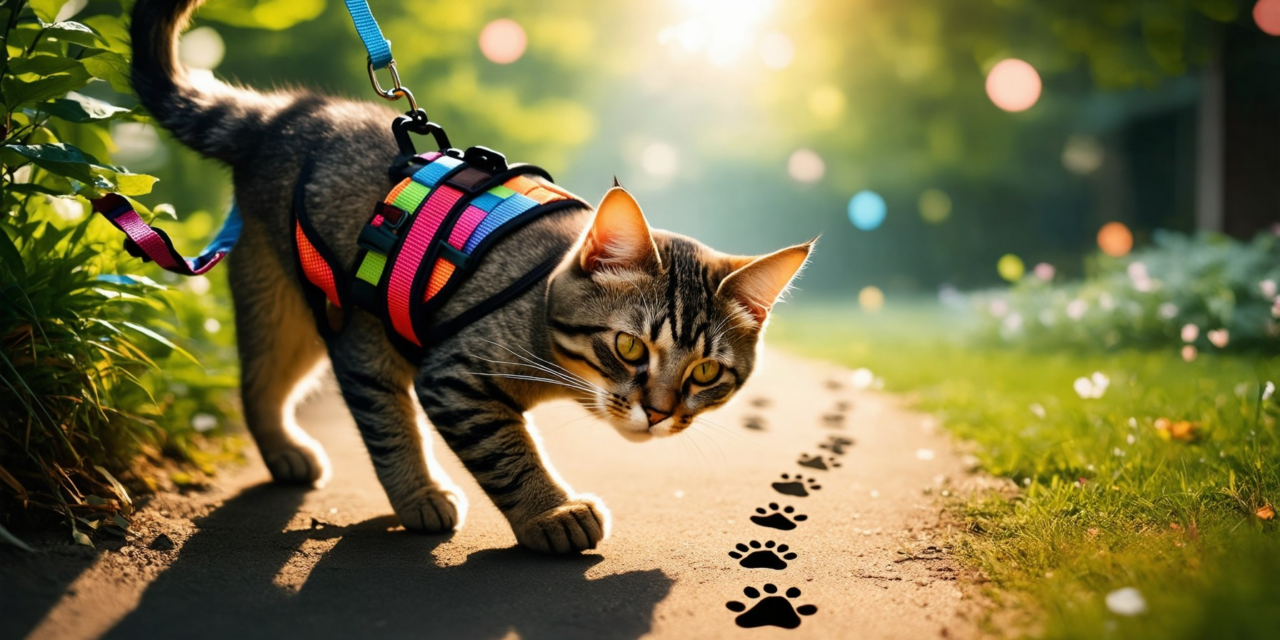Key Takeaways
- Safe Outdoor Exploration: A cat leash provides a secure way for indoor cats to enjoy the outdoors, stimulating their senses and enriching their lives.
- Physical and Mental Health: Regular walks on a leash can help prevent obesity and provide essential exercise for your feline friend.
- Comfort and Safety: Choosing a well-fitted cat harness is crucial to prevent injury and ensure comfort during walks.
- Gradual Training: Introduce the leash and harness slowly to reduce stress and help your cat acclimate to the experience.
- Positive Reinforcement: Use treats and praise to create a positive association with leash walking, enhancing your cat’s willingness to participate.
- Environmental Awareness: Always supervise walks and be mindful of potential dangers, ensuring a safe experience for your cat.
- Consult Your Veterinarian: Before starting leash training, consult your vet, especially for older cats or those with health concerns.
Are you considering taking your feline friend on outdoor adventures? The cat leash has emerged as a popular tool for pet owners looking to safely explore the great outdoors with their cats. In this article, we will delve into the benefits and challenges of using a cat leash, addressing common questions such as, “Are cat leashes a good idea?” and “Is it ever too late to leash train a cat?” We will also explore whether a cat harness might be a better choice for your pet, comparing the differences between cat leashes and cat harnesses. Additionally, we’ll provide insights on how to encourage your cat to walk on a leash, the pros and cons of using cat collars, and tips for safely introducing your indoor cat to outdoor walks. By the end of this article, you will have a comprehensive understanding of the cat leash with harness options available, ensuring your cat’s safety and enjoyment during your shared adventures.
Are cat leashes a good idea?
When considering whether cat leashes are a good idea, it’s essential to weigh the pros and cons based on your cat’s temperament and the environment. Here are key points to consider:
- Stress and Vulnerability: Cats are inherently territorial creatures that prefer to explore their surroundings independently. Being on a leash can induce feelings of vulnerability and stress, particularly for those not accustomed to it (Source: American Association of Feline Practitioners).
- Safety Concerns: Harnesses and leashes can pose safety risks. They may become entangled, leading to potential injury if a cat attempts to escape or climb (Source: ASPCA).
- Potential for Injury: Cats can injure themselves by pulling against a leash or harness, especially if startled. This risk is heightened in unfamiliar environments where they may feel threatened (Source: Veterinary Clinics of North America).
- Individual Comfort Levels: Not all cats are comfortable with harnesses and leashes. Forcing a cat into this situation can lead to unnecessary stress and anxiety. It’s crucial to assess your cat’s comfort level before proceeding (Source: Cat Behavior Associates).
- Exposure to Dangers: Walking a cat on a leash exposes them to potential dangers, such as aggressive dogs, other animals, and traffic. This can be particularly concerning in urban areas (Source: Journal of Feline Medicine and Surgery).
- Natural Instincts: Leashed walks can restrict a cat’s natural behaviors, such as exploring, hunting, and socializing. These instincts are vital for their mental and physical health (Source: Animal Behavior Science).
- Introducing Outdoor Experiences: For cats new to the outdoors, a leash and harness can facilitate a gradual introduction under supervision. This can help them acclimate to new sights and sounds safely (Source: The Cat Fanciers’ Association).
- Comfortable Cats: If your cat is naturally comfortable with a harness and leash, and you can ensure their safety, leashed walks can provide enrichment and exercise. This can be beneficial for indoor cats needing stimulation (Source: PetMD).
- Gradual Introduction: Start by introducing the harness and leash indoors, allowing your cat to adjust before venturing outside. This gradual approach can help reduce anxiety (Source: The Humane Society).
- Choosing the Right Equipment: Select a cat-specific harness and leash that are secure and comfortable. A well-fitted harness is crucial to prevent escape and injury (Source: International Cat Care).
- Short and Supervised Walks: Begin with short walks in a controlled environment, gradually increasing duration as your cat becomes more comfortable. Always supervise to ensure safety (Source: Cornell University College of Veterinary Medicine).
- Positive Reinforcement: Use treats and praise to reward your cat for calm behavior during walks. This can help create a positive association with the experience (Source: Animal Behavior Society).
- Monitoring Reactions: Pay attention to your cat’s body language. If they show signs of stress or anxiety, it’s best to end the walk and try again later (Source: Feline Behavior Solutions).
- Weather Considerations: Avoid walking your cat in extreme weather conditions, as this can be uncomfortable and potentially harmful (Source: The Cat Health Guide).
- Leash Control: Keep the leash short to maintain control and ensure your cat’s safety during walks (Source: The Association of Professional Dog Trainers).
- Awareness of Surroundings: Always be vigilant for potential dangers, including other animals and traffic, to protect your cat during walks (Source: Veterinary Partner).
- Age Considerations: Older cats may struggle with the stress of walking on a leash. Assess their health and comfort level before deciding to take them out (Source: American Veterinary Medical Association).
- Veterinary Consultation: If you have concerns about your cat’s ability to handle leashed walks, consult with your veterinarian for tailored advice (Source: The American Animal Hospital Association).
Benefits of using a cat leash
Using a cat leash can offer several benefits, particularly for indoor cats or those that have limited outdoor experiences. Here are some advantages:
- Safe Exploration: A cat leash allows your feline friend to explore the outdoors safely, providing them with new sights, sounds, and smells while keeping them secure.
- Physical Exercise: Regular walks can help maintain your cat’s physical health, preventing obesity and promoting overall fitness.
- Mental Stimulation: Outdoor experiences can stimulate your cat’s mind, reducing boredom and associated behavioral issues.
- Bonding Time: Walking your cat can strengthen your bond, as it provides quality time together in a new environment.
- Controlled Environment: A leash allows you to control your cat’s movements, protecting them from potential dangers like traffic or aggressive animals.
Safety considerations for leashed cats
While there are benefits to using a cat leash, safety should always be a priority. Here are some important safety considerations:
- Proper Equipment: Ensure you use a well-fitted cat harness and leash designed specifically for cats. Avoid using a collar alone, as it can pose choking hazards.
- Supervision Required: Always supervise your cat during walks to prevent accidents and ensure their safety.
- Environment Awareness: Be mindful of your surroundings, avoiding busy streets or areas with aggressive animals.
- Health Check: Consult your veterinarian before starting leash training, especially if your cat has health concerns or is older.
- Emergency Preparedness: Have a plan in place for emergencies, including knowing how to quickly secure your cat if needed.

Is it ever too late to leash train a cat?
Yes, it is never too late to leash train a cat. Cats of all ages, including seniors, can learn to walk on a leash with patience and the right techniques. Here are some key points to consider when training your cat:
- Start Slow: Introduce the harness gradually. Allow your cat to sniff and explore the harness before putting it on. This helps them associate the harness with positive experiences.
- Choose the Right Harness: Select a well-fitting, comfortable harness designed specifically for cats. A good harness should be secure but not restrictive, allowing your cat to move freely.
- Positive Reinforcement: Use treats and praise to encourage your cat during training sessions. Reward them for wearing the harness and for any progress made while walking.
- Short Sessions: Begin with short training sessions in a safe, familiar environment. Gradually increase the duration and complexity of the training as your cat becomes more comfortable.
- Observe Body Language: Pay attention to your cat’s body language. If they seem stressed or uncomfortable, take a step back and allow them to acclimate at their own pace.
- Practice Indoors First: Before venturing outside, practice walking indoors. This helps your cat get used to the sensation of the leash and harness without the distractions of the outdoors.
- Safety First: Always supervise your cat while on a leash. Avoid busy or noisy areas until your cat is fully accustomed to walking on a leash.
Research indicates that leash training can provide mental stimulation and exercise for cats, contributing to their overall well-being (American Association of Feline Practitioners). Additionally, older cats can benefit from the physical activity and engagement that leash walking offers, promoting a healthier lifestyle.
In conclusion, with the right approach and a commitment to patience, you can successfully leash train a cat at any age, enhancing their quality of life and strengthening your bond.
Common challenges in leash training
Leash training a cat can come with its own set of challenges. Understanding these obstacles can help you navigate the process more effectively:
- Resistance to the Harness: Many cats may initially resist wearing a harness. It’s essential to introduce the harness slowly and positively, allowing your cat to become accustomed to it over time.
- Fear of the Outdoors: Some cats may be apprehensive about going outside. Start by letting them explore the yard or a quiet area while on a leash, gradually increasing their exposure to new environments.
- Distractions: Outdoor environments can be overwhelming for cats. Begin training in a low-distraction area and gradually introduce more stimulating surroundings as your cat becomes more comfortable.
- Short Attention Span: Cats can have shorter attention spans than dogs. Keep training sessions brief and engaging to maintain their interest and focus.
- Inconsistent Training: Consistency is key in leash training. Regular practice will help reinforce positive behaviors and make the process smoother.
By being aware of these common challenges, you can tailor your training approach to better suit your cat’s needs, making the leash training experience more enjoyable for both of you.
Is a Cat Leash Better Than a Cat Harness?
When considering whether a cat leash is better than a cat harness, it’s essential to understand the differences in safety, comfort, and functionality for your feline friend.
Differences Between Cat Leashes and Harnesses
1. **Safety Considerations**:
– A cat collar, while useful for identification, should not be used for walking. Collars can pose a risk of injury, especially if they become snagged on objects. Safety collars that release under pressure are recommended for everyday wear but not for leash walking.
– Harnesses are specifically designed to distribute pressure across a cat’s body, reducing the risk of injury to the neck and throat. This makes harnesses a safer option for outdoor adventures.
2. **Comfort and Fit**:
– A well-fitted harness allows for freedom of movement while preventing escape. Look for harnesses that are adjustable and made from breathable materials to ensure your cat’s comfort during walks.
– Cats can be sensitive to restrictive gear, so it’s crucial to choose a harness that fits snugly but not too tightly, allowing for natural movement.
Best Cat Harness Options for Safety
1. **Types of Harnesses**:
– There are various types of cat harnesses available, including vest-style and H-style harnesses. Vest-style harnesses provide more coverage and can be more comfortable for some cats, while H-style harnesses are easier to put on and take off.
– Popular options include the Petco cat harness and the Amazon cat harness, both known for their durability and comfort.
2. **Recommendations**:
– When selecting a cat harness, consider options that have been positively reviewed by other cat owners. The best cat harness on Reddit often comes highly recommended for its ease of use and comfort.
– Ensure that the harness you choose is suitable for your cat’s size and weight, as this will enhance their safety and comfort during walks. Always check for adjustable features to accommodate your cat’s growth or changes in weight.
By understanding the differences between a cat leash and a cat harness, you can make an informed decision that prioritizes your cat’s safety and comfort during outdoor adventures. For more information on cat leash training, check out my guide on cat leash training.
Why Won’t Cats Walk on a Leash?
Cats are known for their independent nature, which can make leash walking a challenge. Here are several reasons why your cat may resist walking on a leash, along with tips to improve the experience:
- Instinctual Behavior: Cats are natural hunters and explorers, but they prefer to do so in familiar environments. A leash can feel restrictive and may trigger their instinct to flee or hide. Gradually introducing the leash in a safe space can help them acclimate.
- Training and Patience: Unlike dogs, cats require a different approach to training. Consistency and patience are key. Start by allowing your cat to wear the harness indoors for short periods, gradually increasing the time as they become more comfortable.
- Harness vs. Collar: Using a harness is crucial for safety and comfort. Collars can slip off or cause injury. A well-fitted harness distributes pressure evenly and allows for better control. Look for harnesses specifically designed for cats, which often have adjustable straps for a secure fit.
- Positive Reinforcement: Reward your cat with treats and praise when they show interest in the leash or harness. This positive reinforcement can help them associate the leash with enjoyable experiences.
- Environmental Factors: Cats can be sensitive to their surroundings. If your cat is hesitant to walk on a leash, consider the environment. Start in a quiet, familiar area before venturing into busier locations. Gradually introduce them to new sights and sounds.
- Health Considerations: If your cat shows extreme reluctance or distress, consult with a veterinarian. There may be underlying health issues affecting their behavior.
- Professional Guidance: If you’re struggling to train your cat, consider seeking advice from a professional animal behaviorist or a pet trainer who specializes in feline behavior. They can provide tailored strategies to help your cat adapt to leash walking.
By understanding your cat’s behavior and employing these strategies, you can create a more enjoyable and successful leash walking experience. For further insights into pet behavior and training, resources from reputable organizations like the ASPCA can be beneficial.
Strategies to Encourage Walking on a Leash
To help your cat become more comfortable with walking on a leash, consider the following strategies:
- Start Slow: Begin by letting your cat wear the kitten harness and leash indoors. Allow them to explore their surroundings while wearing it to build familiarity.
- Short Sessions: Keep initial outdoor sessions brief. Gradually increase the duration as your cat becomes more accustomed to the leash.
- Use Treats: Bring along your cat’s favorite treats to encourage them to walk. Reward them for taking steps forward while on the leash.
- Choose the Right Time: Select a calm time of day for walks when there are fewer distractions. Early mornings or late evenings can be ideal.
- Be Patient: Every cat is different. Some may take longer to adjust than others. Patience is essential in the leash training process.
Implementing these strategies can significantly enhance your cat’s experience with a cat leash and harness, making walks enjoyable for both of you.

Should I take my indoor cat on walks?
Taking your indoor cat on walks can be a topic of debate among pet owners. Here are some key considerations:
- Safety Concerns: Indoor cats are not accustomed to the dangers of the outdoors, such as traffic, predators, and other animals. A harness and lead can provide some control, but it’s essential to assess your cat’s temperament and comfort level with outdoor environments.
- Physical and Mental Stimulation: While indoor cats can benefit from the exercise and mental stimulation that outdoor walks provide, it’s crucial to create a safe and enriching indoor environment. Interactive toys, climbing structures, and puzzle feeders can help simulate the exploration and activity they would experience outdoors.
- Gradual Introduction: If you decide to take your cat on walks, introduce them gradually to the harness and lead. Allow them to explore the harness indoors before venturing outside. Start with short walks in a quiet area to help them acclimate.
- Health Benefits: Regular exercise is vital for maintaining a healthy weight and preventing obesity-related health issues in cats. According to the Association for Pet Obesity Prevention, nearly 60% of cats in the U.S. are overweight or obese. Walking can be a beneficial part of their routine, provided it’s done safely.
- Alternative Options: Consider alternatives to walking, such as leash training in a secure outdoor enclosure or using a catio (cat patio) that allows your cat to enjoy the outdoors safely without the risks associated with free roaming.
- Consulting a Veterinarian: Before making any changes to your cat’s routine, it’s advisable to consult with a veterinarian. They can provide personalized advice based on your cat’s health, behavior, and lifestyle.
In conclusion, while taking your indoor cat on walks can be beneficial for exercise and mental stimulation, it’s essential to prioritize their safety and comfort. Creating a stimulating indoor environment may often be a better option for their overall well-being.
Benefits of outdoor exploration for indoor cats
Outdoor exploration can significantly enhance the quality of life for indoor cats. Here are some benefits:
- Enhanced Sensory Experience: The sights, sounds, and smells of the outdoors provide a rich sensory experience that indoor environments often lack.
- Physical Exercise: Walking on a leash encourages physical activity, helping to maintain a healthy weight and prevent obesity.
- Behavioral Enrichment: Exposure to new environments can reduce boredom and stress, leading to improved behavior and mental health.
- Socialization: Outdoor walks can help cats become more accustomed to different people and animals, enhancing their social skills.
By carefully considering these factors, you can make informed decisions about taking your indoor cat on walks and ensuring their well-being.
What are the cons of a cat collar?
While cat collars can be beneficial for identification and safety, they also come with several potential drawbacks:
- Risk of Injury: Cats are inherently curious and adventurous. A collar can become snagged on branches, fences, or furniture, posing a risk of choking or injury. According to the American Veterinary Medical Association (AVMA), breakaway collars are recommended to mitigate this risk, as they are designed to release when pulled with sufficient force.
- Skin Irritation: Continuous wear of a collar, especially if it is not fitted correctly, can lead to skin irritation or abrasions. The friction from the collar can cause discomfort and even infections. A study published in the Journal of Feline Medicine and Surgery emphasizes the importance of regularly checking the fit and condition of a collar to prevent such issues.
- Behavioral Changes: Some cats may exhibit stress or anxiety when wearing a collar, particularly if they are not accustomed to it. This can lead to changes in behavior, such as increased hiding or aggression. A study in the Journal of Veterinary Behavior suggests that gradual acclimatization to wearing a collar can help alleviate these issues.
- False Sense of Security: Relying solely on a collar for identification can be misleading. If a collar falls off or is removed, the cat may become lost without any means of identification. Microchipping is a more reliable method for ensuring a cat can be returned home if lost, as highlighted by the American Animal Hospital Association (AAHA).
- Potential for Allergic Reactions: Some cats may develop allergies to the materials used in collars, such as nylon or certain dyes. Symptoms can include itching, redness, or swelling. It is advisable to monitor your cat for any adverse reactions and consult a veterinarian if concerns arise.
In conclusion, while collars can serve a purpose, it is crucial for cat owners to weigh these potential cons against the benefits. Regular monitoring and consideration of alternatives, such as microchipping, can enhance your cat’s safety and well-being.
Risks associated with cat collars
Understanding the risks associated with cat collars is essential for ensuring your pet’s safety. Here are some key points to consider:
- Breakaway collars are essential to prevent choking hazards.
- Regularly check for signs of irritation or discomfort.
- Consider microchipping as a more secure identification method.
- Monitor your cat’s behavior when introducing a collar.
Alternatives to collars for safety
If you’re concerned about the drawbacks of cat collars, there are several alternatives that can enhance your cat’s safety:
- Microchipping: A permanent identification method that ensures your cat can be returned if lost.
- GPS Trackers: Devices that can be attached to a harness for real-time tracking.
- Harnesses: A cat harness can provide more control and safety during outdoor activities.
Cat leash with harness: A comprehensive guide
When considering a cat leash with harness, it’s essential to understand the various options available and how they can enhance your cat’s outdoor experience. A well-chosen cat harness and leash combo can provide safety and comfort, allowing your feline friend to explore the world outside while remaining secure.
Choosing the right cat harness and leash combo
Choosing the right cat harness and leash combo is crucial for a successful outdoor experience. Here are some key factors to consider:
- Fit and Comfort: Ensure the harness fits snugly but is not too tight. It should allow your cat to move freely without slipping out. Look for adjustable options that can accommodate your cat’s unique body shape.
- Material: Opt for breathable materials that are gentle on your cat’s skin. Soft fabrics can prevent chafing during walks.
- Type of Harness: There are various styles, including vest-style and H-style harnesses. Vest-style harnesses distribute pressure more evenly and are often recommended for cats.
- Leash Length: A longer leash can give your cat more freedom to explore, but ensure it’s manageable for you to control. A retractable leash for cats may also be an option to consider.
For reliable options, check out PetSmart or Petco for a range of cat harnesses and leashes.
Cat harness and leash escape proof options
Safety is paramount when using a cat leash. Here are some escape-proof options to consider:
- Secure Fastenings: Look for harnesses with multiple secure fastenings to prevent accidental escapes. Velcro combined with buckles can provide extra security.
- Design Features: Some harnesses come with additional features like reflective strips for visibility during evening walks or padded straps for added comfort.
- Testing the Fit: Before venturing outside, test the harness indoors. Allow your cat to wear it for short periods to ensure they are comfortable and accustomed to it.
For a variety of cat harnesses at PetSmart, visit PetSmart or explore options on Amazon for cat harnesses that are designed to keep your pet secure.













